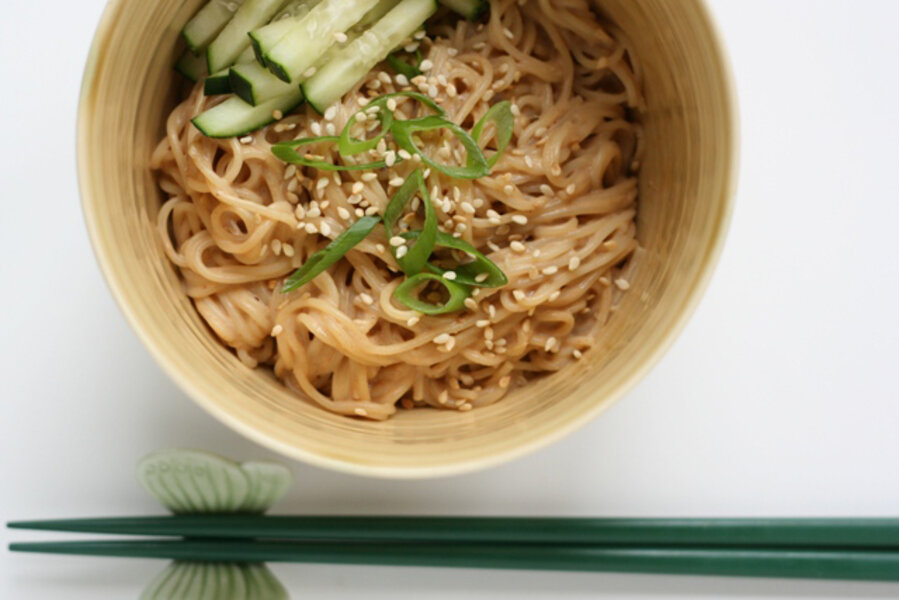Who needs authentic? Try peanut butter on those sesame noodles.
Loading...
“Authentic” is a loaded word, especially when it comes to food. In Singapore – where I was raised, and in my opinion, the birthplace of Asian fusion cuisine – authentic is subjective. Mee goreng, a local favorite, brings together Chinese egg noodles, Western potatoes, bottled tomato ketchup, and Indian spices. The lunch standard, laksa, is made with a soup base founded on a Malay spice paste and coconut milk, poured over thick Chinese rice noodles and garnished with laksa leaf (commonly known by its Vietnamese name, rau ram).
Are these dishes authentic? To a Singaporean of Indian or Chinese ethnicity, yes. But to an Indian from Mumbai or a Chinese born and bred in Beijing, probably not. The big question is: Does it matter?
For some, it does. For others, like my dad who pours kecap manis (Indonesian sweet soy sauce) on everything, including spaghetti, it’s a matter of taste, and that is all that matters. As for me, let’s just say I’ve gradually come to embrace the inauthentic.
When I first came to the Unite States, I was appalled at all the pseudo-Asian cuisine I came across. I think I was more aggrieved by how bad the food tasted rather than the fact that dishes were a poor facsimile of what I was used to back home. In Singapore, you’d go out of business very quickly if you served bad food regardless of cuisine.
My solution was to learn how to cook: Everything from my favorite Indonesian comfort foods to a few Singapore dishes I used to enjoy eating at hawker centers. I also learned to appreciate other Asian cuisines – Vietnamese, Thai, Korean – that I wasn’t exposed to in my childhood years. I didn’t know if the food was authentic, but I could definitely discern if a dish was good.
As a newbie cook, I couldn’t find all the ingredients my mom mentioned over the phone. Many of the items listed in the cookbooks I brought over were nowhere to be found (or maybe they went by different names?). It was then I realized that as immigrants, whether our generation or generations that came before us, we’ve had to adapt to our surroundings. We’ve used our initiative to find substitutes for ingredients that were ubiquitous at home, using broccoli instead of Chinese broccoli in stir fries, swapping lime juice for tamarind in pad Thai. (Of course, in many cosmopolitan US cities today you can find just about everything you might need at an Asian or Latino market.)
In addition, I decided that I preferred to use chicken in place of beef in my mom’s famous rendang (braised beef curry). In a bid to eat healthy, I added green peas to my childhood comfort food macaroni schotel (the Spam stays though – what irony!). Have I “in-authenticized” these dishes? I don’t think so. I call it evolution.
Chinese sesame noodles are originally made with Chinese sesame paste but you’d have to make a trek to the Asian market to get some. You could use tahini but I choose peanut butter because it’s readily available and I find it easier to bribe kids (and some adults) with peanut butter rather than sesame paste. If you have allergies in the family, opt for almond or sunflower butter instead. Is the final dish authentic? Probably not, but honestly, I don’t care.
Peanut butter sesame noodles
Time: 30 minutes
Makes: 2 servings for big appetites or 4 for normal ones
8 ounces soba or spaghetti (I like whole wheat but you don’t have to subject yourself to it if you don’t want to), cooked according to package directions
2 cloves garlic, roughly chopped
Thumb-size piece ginger (about 2-inches), grated or minced (peeling is optional)
1/2 cup peanut butter (preferably a brand that contains only peanuts, i.e. no added oil, sugar or salt)
2 tablespoons brown sugar or honey
1/4 cup water
3 tablespoons soy sauce
3 tablespoons rice vinegar or distilled white vinegar
2 tablespoons sesame oil
Squirt or two of chili sauce like Sriracha or sambal oelek (optional)
Garnish
1 cucumber, cut into matchsticks
2 green onions, chopped
4 teaspoons toasted sesame seeds
1. After rinsing the cooked noodles with cold water, leave them in a colander in the sink to drain. Stir to separate the strands.
2. Combine the garlic, ginger, peanut butter, brown sugar, water, soy sauce, rice vinegar, and sesame oil in a blender. Blend until smooth, 20 to 30 seconds. Taste and adjust seasonings if desired.
3. Put the drained noodles in a large bowl and pour half the peanut dressing over. Gently toss with tongs or chopsticks and keep adding the dressing until the noodles are evenly coated with just the right amount for your taste (toss any remaining dressing with greens).
4. Divide the noodles into four bowls and garnish with cucumber, green onions and 1 teaspoon sesame seeds per bowl.








